The Sherman M4A2 Medium Tank
These two Sherman M4A2 British Medium Tanks with a cast turret, welded hull and 75mm gun can be found at the French Tank Museum in Saumur in the Loire Valley. The Museum is called Musée des Blindés ou Association des Amis du Musée des Blindés, 1043, route de Fontevraud, 49400 Saumur, France www.museedesblindes.fr . The word Blindés means armoured.
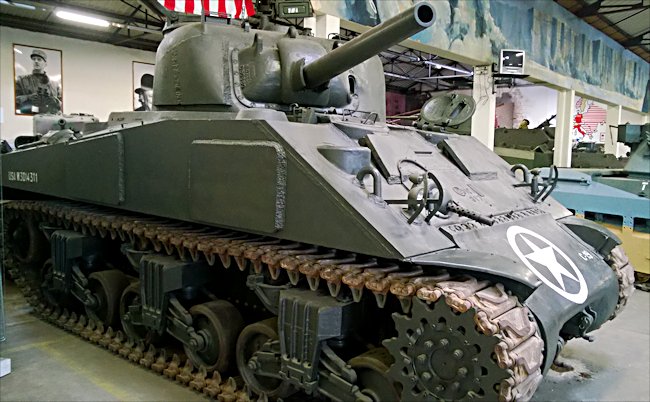
Sherman M4A2 Medium Tank at the French Tank Museum
Sherman Tanks spend winter of 1944 in Germany
In November 1944 the American troops encountered some of the worst combat of the war in the Hurtgen forest south east of the German city of Aachen that was now in American hands. With their troops tired from months of fighting their invasion of Germany halted. A stalemate set in on the front lines. The Allies used this time to repair tanks and prepare for the next stage in the war.
On the 16th December 1944 it was the Germans who launched a massive armoured offensive taking the Allies by surprise. The Battle of the Bulge had begun. The German plan was to slice through enemy lines and drive towards Antwerp. Trapping more than a million allied troops in northern Belgium and Holland.
But after six weeks of bitter fighting the German offensive ground to a halt, blunted by Allied reinforcements. Hitler’s gamble proved costly, loosing hundreds of much needed panzers in the fighting and many just abandoned through lack of fuel. This now meant that Germany’s military power was only defensive and reactionary rather than aggressively initiating the tone of an attack.
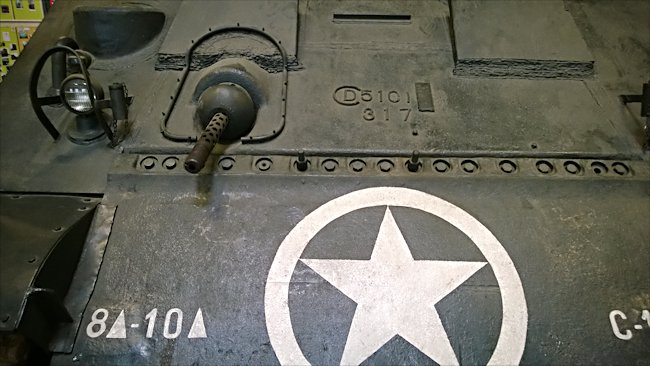
Notice that the front bottom section of the hull of the Sherman M4A2 Tank is in one piece unlike the M4A4 Sherman
As the Germans retreated in the west the Soviet Union started a new initiative in the east. The red army smashed it way through German lines in the Baltics, east Prussia and Poland. By early February Soviet tanks were just 80km from Berlin.
On the Western front the Allies now resumed their invasion of Germany. Their first objective was to seize bridges over the Rhine river. This vast waterway was a natural barrier to any advance into central Germany. Sherman tanks from the 1st Canadian Army were to advance through the Hochwald gap and capture key German bridges over the Rhine near the town of Xanten. As the Canadian’s moved further into Germany they had to overcome fierce German resistance.
Lt. Danny McLeod of the Canadian 1st Armoured Division said "The German’s livelihood depended on keeping the Allies from seizing the bridges. If we seized the bridges it would be no time until the industrial lifeline of the Rhur would be surrounded." They managed to hold down a force five times their size for 31 days. It was only after weeks of intense combat that they were finally able to overcome German resistance and get to the Rhine. When they finally crossed the Rhine and moved deeper into Germany they say the effect that the war had had on the civilian population.
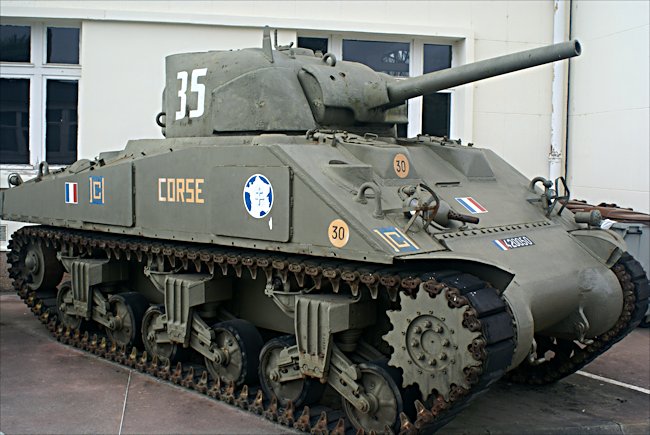
Free French Sherman M4A2 Medium Tank stands guard by the entrance to the French Tank Museum in Saumur.
Trooper Jack Gardiner of the 4th Canadian Armoured Division commented, "We were approaching this small town. It was called Wesel. Prior to us arriving there RAF Typhoon rocket firing ground attack aircraft, strafed the town and messed the town up terribly. Going through the town, man we could not believe it. Rubble on both sides of the road piled up. Homes totally gone, but people were around. They had carts and were picking up bodies to put in the carts."
In the first two months of 1945 500,000 soldiers and civilians became casualties. The German Army also lost nearly 1,000 tanks. A lot of the German reinforcements coming up to the western front were passing through the civilian areas that had been bombed by the Allies and this added to their resolve to give payback.
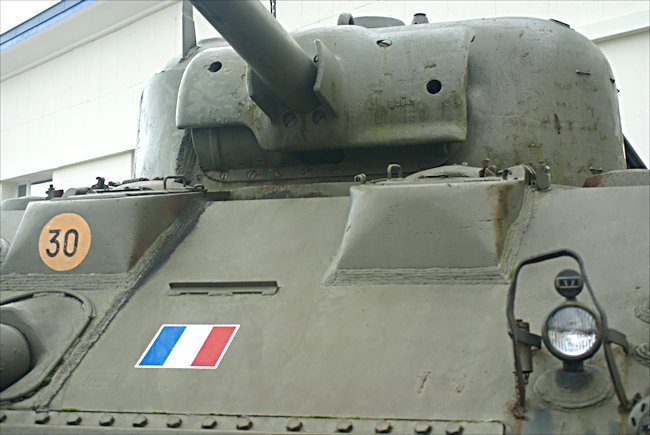
This Sherman M4A2 Medium Tank does not have the additional protective welded plates in front of the drivers positions
It was German troops like these that the US 3rd Armoured Divison must now face as they resumed their advance into Germany. They would help capture the biggest western target in Germany, Cologne (Koln). By seizing this major city on the banks of the river Rhine they could open up a route into central Germany. The Germans did not want to give it up. The Americans had a hard battle on their hands.
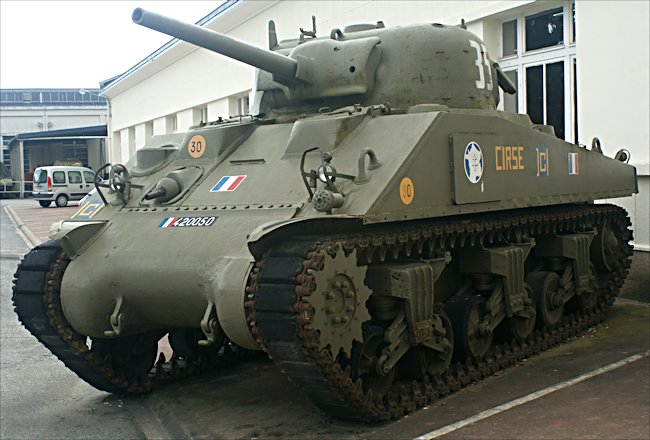
This Sherman M4A2 Medium Tank has the the rubber road track fitted.
Cpl. Clarence Smover was a Sherman tank commander with the 3rd Armoured Division at that time and had a lucky break, "We finally moved into this Cologne city road intersection amongst the rubble. A German tank had come into the intersection to my left just far enough that he saw us. So he backed away round a building. I fired armoured piercing shells through the building. I figured may be I would get a lucky hit. The top of the building collapsed and fell on top of the Panzer IV tank. They could not turn their gun. They could not rotate their turret because there was so much rubble on it. He crew abandoned the tank and were captured.
The first M4 Sherman tank night attack - Operation Totalize
The first attempt by the British, Canadian and Polish forces to attack and hold the dominating Verrières Ridge south of Caen called Operation Goodwood failed. The Germans held the high ground and could see everything the Allies were doing. Their anti-tank guns, the infamous 88mm. was accurate over very long ranges and its shells could easily penetrate the armour of a M4 Sherman Tank.
Canadian lieutenant-General Guy Simmonds comes up with a plan that will become known as operation Totalize to capture the problematic Verrières Ridge. His plan is to send the first ever armoured night attack down either side of the main southbound road out of Caen supported by infantry carried in armoured personnel carriers so they could keep up with the tanks, be safe from machine-gun fire and deal with enemy soldiers using anti-tank Panzerfaust bazookas.
It called for 400 tanks, mainly M4 Shermans, to rush forward in six columns under the cover of darkness and a rolling artillery barrage. A nocturnal military operation on this scale had never been tried before. It was very ambitious and risky. Simmonds orders his infantry and tanks to practice the attack and moving in columns again and again in daylight.
Canadian Sherman tank commander Captain S.V. Radley-Walters of the Sherbrooke Fusiliers regiment took part in those training sessions. "Getting ready for Operation Totalize was basically about a week of hard work. They made up a line of four tanks. Behind those tanks they put four more. Behind those tanks they put four anti-mine flail tanks. Behind that another four flails and then four companies of infantry in armoured carriers and so on. Everything tracked not one wheeled vehicle at all."
On the night of 8th August 1944 at 11.30pm, after a massive artillery barrage Operation Totalize begins. The mass of tanks lurch forward into the darkness. British tank crew member lance-corporal Ken Tout, 1st Northamptonshire Yeomanry commented. "You had a mixture of emptions as you started the attack. You were afraid, you were proud, you were thrilled and you were bewildered. All you saw was the red tail light of the tank in front. So you fixed your eyes on that and followed for your life’s sake. It was total chaos with flashes going on all over the place. On the way you saw some Germans in slit trenches but you had been told not to stop, keep going. You saw one of your tanks in front of you hit and going up in flames. You saw another one hit and going up in flames. You did not know what was happening. You kept going, you just kept going."
Captain S.V. Radley-Walters recalls, "The buggers had laid mines knowing reasonably the route we would have to go. You could hear the shooting going on all over the place."
The tanks stay close together as they crawl slowly towards the ridge. The commander was following the lines of tracer fire being shot over their heads to show them what way to go. The compasses they had been given did not work after the artillery barrage. The anti-aircraft white beams that were being shone in the direction of travel as a navigations beam could hardly be seen for all the dust. Some tanks fall into shell craters and cannot get out.
By dawn of 8th August 1944 the Allies had reached Verrières Ridge forcing the Germans to retreat. By noon the whole ridge was in Allied hands. The first use of armoured night attacks had proven itself to be a valid tactic.
Where can I see more Sherman M4A2 tanks?
- Association de Sauvegarde du Patrimoine Historique Militaire. 1 Rue Georges Cuvier, La Watzenau, France
WW2 tank books

